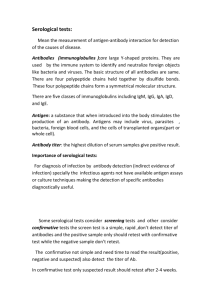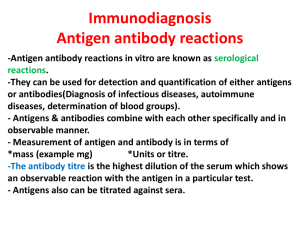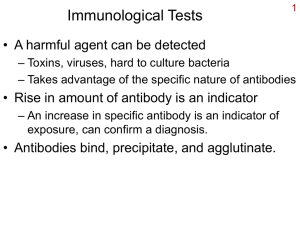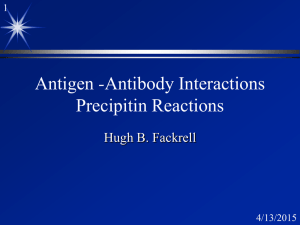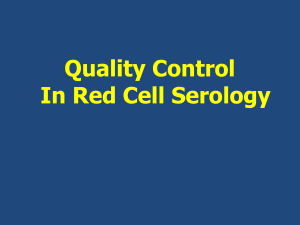antigen- antibody reactions - SOUTHERN MEDICAL UNIVERSITY
advertisement
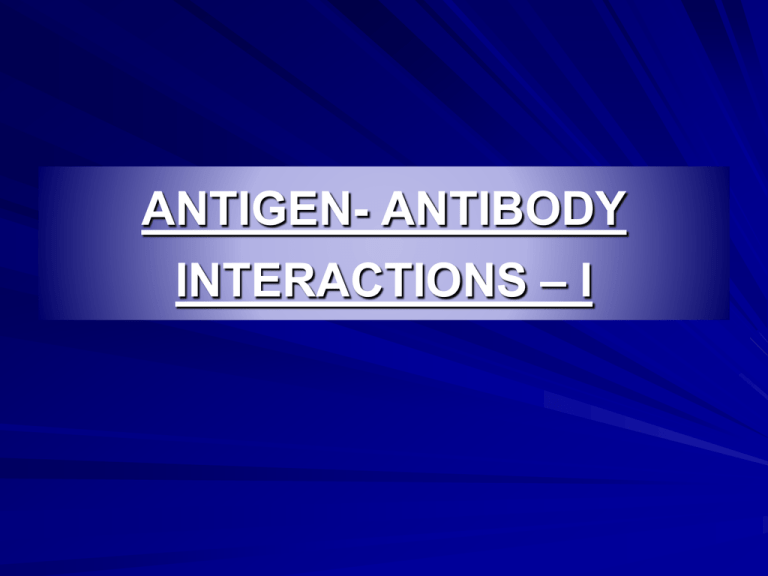
ANTIGEN- ANTIBODY INTERACTIONS – I ANTIGEN- ANTIBODY REACTIONS Antigens and antibodies combine with each other specifically and in an observable manner Serological reactions : Antigen –antibody reactions in vitro Uses :- In vivo 1. Basis of antibody mediated immunity in infectious diseases 2. Tissue injury in hypersensitivity and autoimmune diseases In Vitro :1. Diagnosis of infections in laboratory 2. In epidemiological surveys 3. Detection of non infectious agents - enzymes 4. Detection and quantification of either Ag or Ab Stages of Reactions Primary stage Secondary stage - Initial interaction rapid - No visible effect - Reversible - Weaker inter molecular forces - Detected by estimating free and bound Ag or Ab - Visible effects - Precipitation - Agglutination - CF - Neutralization - Immobilization - Zinssser’s Unitarian hypothesis Comparative efficiency of Immunoglobulin classes in different serological reactions IgG IgM IgA Precipitation Strong Weak Variable Agglutination Weak Strong Moderate Complement Fixation Strong Weak Negative General features of Ag – Ab reactions Specificity Entire molecules react No denaturation of Ag or Ab Combination occurs on surface Combination is firm but reversible - Affinity : Intensity of attraction of Ag or Ab molecules - Avidity : Strength of bond after formation of Ag - Ab complexes, reflect overall combining property of various Ab mol in antiserum Both Ag and Abs participates Ags and Abs combine in varying proportions, Abs are bivalent, Ags are multivalent Measurement of Antigen & Antibody In terms of Mass, Units or Titre Antibody titre : Highest dilution of serum showing observable reaction with antigen in a test Two parameters of serological tests are : 1. Sensitivity : Ability of the test to detect minute quantities of antigen or antibody Highly sensitive tests – False negative result is absent 2. Specificity : Ability to detect reactions between homologous Ags and Abs only , and no other Highly Specific test false positive results are absent PRECIPITATION Soluble antigen reacts with its antibody in the presence of electrolytes at an optimum temp and pH, the Ag – Ab complex forms an insoluble precipitate. Occur in liquid media or in gels such as agarose or polyacrylamide Flocculation : Instead of sedimenting, if precipitate is suspended as floccules eg : VDRL Zone phenomenon : - Prozone or zone of antibody excess - Zone of equivalence - Postzone or zone of antigen excess Mechanism : Lattice hypothesis :- Multivalent Ag combines with bivalent Abs in varying proportions, depending on Ag –Ab ration in the reacting mixture Application of Precipitation Qualitative or Quantitative Very sensitive in detecting antigens – 1 μg of protein Ring test : - Eg: Ascoli’s thermo precipitation test Slide test : - VDRL Tube test : - Khan test for syphilis Immuno diffusion : (Precipitation in gel) - Single diffusion in one dimension (Oudin) - Double diffusion in one direction (Oakley- Fulthorpe) - Single diffusion in two dimensions ( Radial ID) - Double diffusion in two dimensions (Ouchterlony) Immunoelectrophoresis : Grabar & Williams - Electrophoretic separation of composite antigens - Followed by immunodiffusion against antiserum - Enables identification and quantitation of various proteins present in serum IMMUNO IMMUNO ELECTROPHORESIS ELECTROPHORESIS Electroimmunodiffusion Methods combining electrophoresis with diffusion Counter immuno electrophoresis (CIE) - Electrophoresis of antigen and antibody in gel in opposite directions resulting in precipitation between them - Visible precipitation in 30 min, 10 times more sensitive than double diffusion - Detecting various Ags such as Alphafetoprotein in serum - Cryptococcus Ags in CSF Rocket Electroporesis : - Quantitative estimation of antigens - Antiserum incorporated in agarose gel - Antigen in increasing concentration placed in wells and electrophoresed in gel AGGLUTINATION A particulate Ag combines with its Ab in presence of electrolytes at an opt temp and pH resulting in visible clumping of particles More sensitive than precipitation for detecting Abs 1. Slide Agglutination : Blood grouping, Bacterial typing 2. Tube Agglutination : quantitative method for Abs - Serum diluted by doubling dilutions in test tubes - Equal volume of particulate Ag is added all tubes - Antibody titre : Highest dilution of serum at which agglutination occurs Eg : Widal test, Brucellosis, Weil Felix, Paul Bunnel Cold agglutination test Demonstration of hemagglutination Demonstration of hemagglutination using antibodies against sheep red blood cells (SRBCs) : The control tube (10) contains only SRBCs, which settle into a solid “button.” The experimental tubes 1–9 contain a constant number of SRBCs plus serial two-fold dilutions of anti-SRBC serum. The spread pattern in the experimental series indicates positive hemagglutination through tube 3. ANTIGLOBULIN TEST (COOMBS TEST) For detection of incomplete anti Rh antibodies When mixed with red cells they coat over them but do not agglutinate Such coated RBC’s treated with antiglobulin or Coombs serum (Rabbit antiserum against human gamma globulin), cells are agglutinated Two types : 1. Direct Coombs test : Sensitisation takes place in vivo Eg : Haemolytic disease of new born 2. Indirect Coombs test : Sensitisation of RBC’s with antibody globulin performed in vitro - Used for detecting any type of incomplete or non agglutinating antibody, eg: Brucelllosis PASSIVE AGGLUTINATION TESTS Precipitation is converted to agglutination Attaching soluble antigen to the surface of a carrier particle such as Latex particles, Bentonite or RBC’s Very sensitive method for detecting antibodies Two types : 1. Latex agglutination : Polystyrene latex (0.8 to 1µm diameter , absorb several types of antigens - ASO, CRP, RA, HCG 2. Haemagglutination : Rose Waaler test in Rheumatoid arthritis, an autoantibody (RA Factor) appears in serum which acts as antibody to gammaglobulin Reverse Passive Agglutination : Instead of antigen, antibody is adsorbed to carrier particles In Agglutination Inhibition, Absence of Agglutination Is Diagnostic of Antigen A modification of the agglutination reaction, called agglutination inhibition, provides a highly sensitive assay for small quantities of an antigen One of the early types of home pregnancy test kits included latex particles coated with human chorionic gonadotropin (HCG) and antibody to HCG. The addition of urine from a pregnant woman, which contained HCG, inhibited agglutination of the latex particles when the anti-HCG antibody was added; thus the absence of agglutination indicated pregnancy Agglutination inhibition assays can also be used to determine whether an individual is using certain types of illegal drugs, such as cocaine or heroin. A urine or blood sample is first incubated with antibody specific for the suspected drug. Then red blood cells (or other particles) coated with the drug are added. If the red blood cells are not agglutinated by the antibody, it indicates the sample contained an antigen recognized by the antibody, suggesting that the individual was using the illicit drug. One problem with these tests is that some legal drugs have chemical structures similar to those of illicit drugs, and these legal drugs may cross-react with the antibody, giving a false-positive reaction. For this reason a positive reaction must be confirmed by a nonimmunologic method Agglutination inhibition assays Agglutination inhibition assays are widely used in clinical laboratories to determine whether an individual has been exposed to certain types of viruses that cause agglutination of red blood cells If an individual’s serum contains specific antiviral antibodies, then the antibodies will bind to the virus and interfere with hemagglutination by the virus. This technique is commonly used in premarital testing to determine the immune status of women with respect to rubella virus The reciprocal of the last serum dilution to show inhibition of rubella hemagglutination is the titer of the serum. A titer greater than 10 (1:10 dilution) indicates that a woman is immune to rubella, whereas a titer of less than 10 is indicative of a lack of immunity and the need for immunization with the rubella vaccine COAGGLUTINATION Protein A on surface of some Staphylococcus aureus (Cowan 1 strain) Specific IgG can be coated on these protein A of Cowan 1 strains Fc portion binds to Protein A, whereas Ag binding Fab remains free The Fab portion binds to specific antigen when mixed leads to agglutination Uses : Detecting bacterial Ags in blood, Urine, CSF for Neisseria gonorrhoea, Strept pyogenes, Haemophilus

